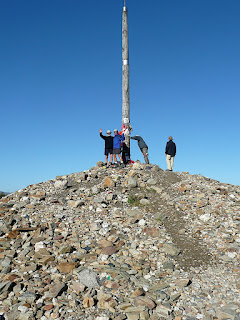With so much walking behind us now -- nearly 650 kilometers -- we recognize we're true peregrinos (pilgrims) of Santiago. Many of us discovered muscles we'd never known existed before.
In our 2,100 foot climb from Villafranca del Bierzo to O Cebreiro we heard barely a peep of complaining. The only signs of the effort were beads of perspiration, caused as much by the sunny day as the exertion. We are now camino tough. Tested, tried, and admittedly a little tired. We are strong walkers who can take on any pilgrimage the ancient traditions of the church could throw at us. Who knows, perhaps next year we'll try the Via Francigena from Canterbury to Rome, or perhaps the greatest of all medieval pilgrimages: the Via Jerusalem from Rome to the Holy City in Israel/Palestine! Well, we can dream.
We left Villafranca del Bierzo early in the morning a few days ago and walked up the old highway, taking the advice of the sign at the foot of the mountain trail option to avoid the steeper climb unless you are an Olympic athlete. The old highway is little used anymore, thanks to the beautiful new A6 freeway that quietly snakes above us on slender concrete piers. After awhile it was back to the path which was actually rather steep with loose gravel for several kilometers. We stopped for photos at the "Welcome to Galicia" monument, a painted and graffitied slab that marks Kilometer 0 of our walk through the semi-autonomous region of Galicia, of which Santiago de Compostela is capital.
At the summit town of O Cebreiro we came to understand why this little village is known throughout Spain. It's a living museum that depicts life the Galician way, with round stone huts and thatched roofs. We could imagine medieval Gallegos wandering through the village, tending their chickens and flocks, scratching out a meager subsistence on this windswept mountain.
Our evening at O Cebreiro was a celebration. We gathered as a group in a delightful pub and shared our first plate of true pulpo gallego, along with our first bowls of genuine caldo gallego, the hearty Galician soup. We started to strategize for our reunion meal back in Seattle. We'd certainly have paella, which Sandy agreed to prepare. We'd also definitely want the two Galician dishes we were just then enjoying. We'd also have to have someone bring Spanish tortilla (perhaps best described as a crustless potato/egg/cheese quiche -- nothing like a Mexican tortilla). Someone would need to bring ample quantities of Riojan wine. And someone would need to make some plates of ensalada mixta, the omnipresent Spanish salad. Surely we could also hunt down some true Spanish jamon and chorizo in Seattle. As we enjoyed planning our feast we realized that one of the joys of the Camino is the cuisine of Spain.
After O Cebreiro we walked on to the tiny and picturesque village of Triacastela. Tonight we took it easy and walked only 10 kms through forests and between small farms to the Monastery of Samos. We realized how important monasteries were to medieval Spain and remembered how throughout Europe they were looted and destroyed because of their power and accumulated wealth. The 14 monks of Samos go about their quiet business in a building that could house hundreds. We joined them at Vespers and were transported to centuries past as they chanted their Latin service.









